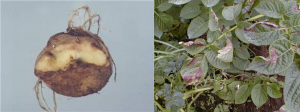The pathogen causes purplish-brown lesions on the surface of tubers. Lesions can be examined further by cutting the tuber and a reddish-brown dry rotted tissue that extends < 1 inch into the tuber can be observed. Often secondary invaders such as bacteria may enter rotted tubers making observations of symptoms difficult.
Lesions caused by the pathogen can occur on leaves or stems. Blackish water soaked lesions occur on the leaves and whitish sporulation of the pathogen can be seen around the margin of the lesions, particularly on the underside of the leaf. On stems, late blight causes brown lesions that look greasy. The lesions commonly occur at the junction of the leaf and stem where water may accumulate or on clusters of leaves at the top of the stem.
Potato tuber (left) with reddish brown discoloration and potato leaf lesions (right) due to infection with P. infestans . Images courtesy of Jean Ristaino, NC State University.

